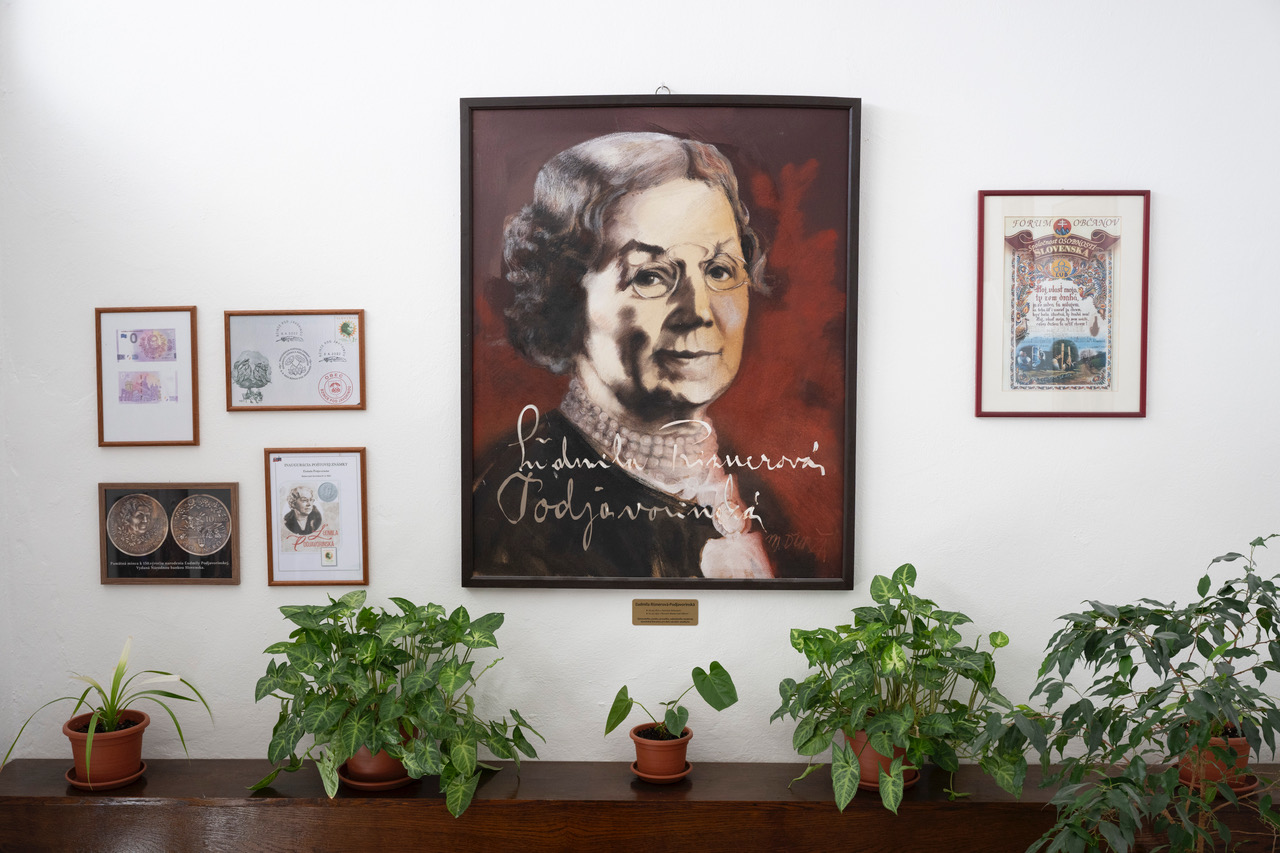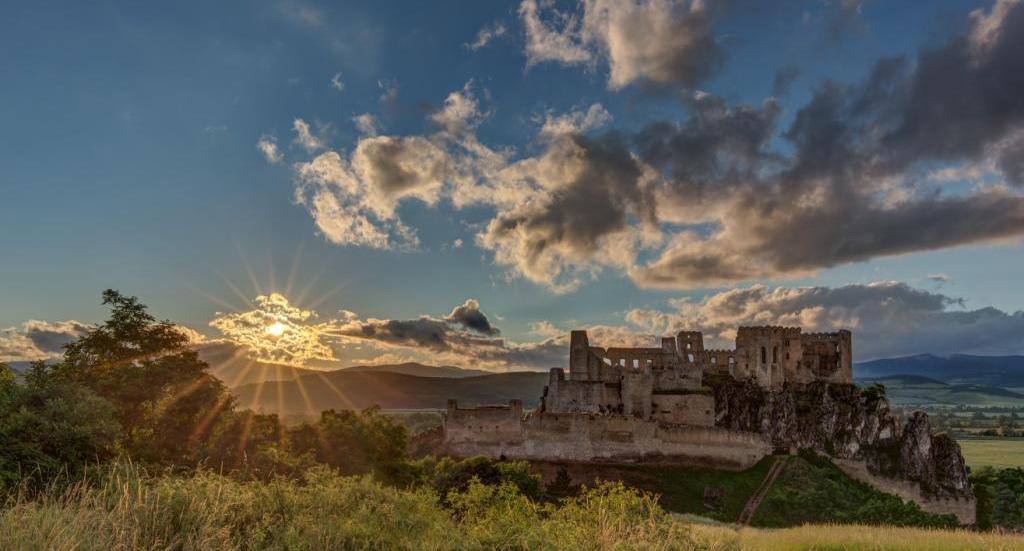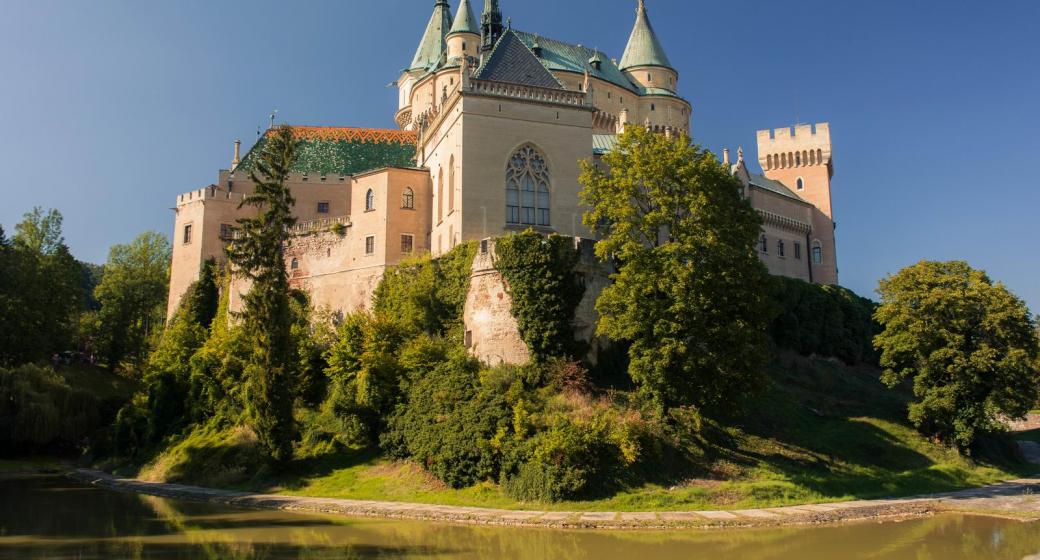


At the end of the region, this time we headed to Bziniec pod Javorinu. Halfway between Nový Mesto nad Váh and Stará Tura, we turn right and slip into the village, which was made famous above all by the writer Ľudmila Podjavorinská. The spring sun is still shining in our eyes, but the arrival of summer can already be felt in the air. After a while, the cool morning air is replaced by a warmer one that caresses the skin pleasantly. With a bit of luck, you will smell blooming linden trees in it. The main road is lined with bushy trees and nature is all around us. Bzince pod Javorina is surrounded by several mountains and hills, among which, as the name of the village suggests, Veľká Javorina stands out - a traditional meeting place of Czechs, Slovaks and Moravians. But let's talk about the first part of the name, that is, Bzinci itself. The linguist Rudolf Krajčovič derived its origin from the word base bez, bza, bushy tree, or elder. This particular plant is abundant here, and the attentive eye will certainly not miss the fact that it is part of the municipal coat of arms.
They don't even have to go to town
On the one hand, Bzince pod Javorinu retains its unique rural character, on the other hand, modern construction is taking place here. The first rental apartments are being built in the center and the building of the municipal office has also been renovated. We stop for a moment at the stand in the municipal market, where Anna Milová sells her products. He doesn't have many customers in the morning, so he willingly exchanges a few words with us. "I've lived here for fourteen years and I have to say that I'm very happy here," she boasts. According to her, the advantage is the availability of key services. "I don't even have to go to the city, because practically everything is here - from a kindergarten, a school, a shop, a health center to a museum," he says. Mayor Dušan Málik is already waiting for us at the municipal office. "Our village is truly exceptional. Slovakian national artist Ľudmila Podjavorinská, known mainly for her work for children, was born here and is also buried here. Last year we commemorated the 150th anniversary of her birth, and this year we commemorate the 80th anniversary of her famous book Chin-Chin," points out the first man of the village
Aunt Ľudmila at every step
The writer is present in several places in the village. Her effigy adorns a massive monument in the shape of a four-leaf clover, which we pass by. The path across the stream takes us right in front of her birthplace. During the previous regime, a memorial room of Ľudmila Podjavorinská was opened in it, which today belongs to the branches of the Trenčín Museum. The house originally served as a school with one classroom, where Karol Rudolf Rizner, Ľudmila's father, had his teacher's apartment. As soon as we step inside, history breathes upon us. "The building is 150 years old," points out long-time guide Ivan Mrázik. The majority of the exhibition is dedicated to Podjavorinska. Here we can find photos from which the calm face of Aunt Ľudmila looks back at us, but also her much younger portraits, tapestries and books. An exhibition of puppet characters is also included. Among the exhibits, the table behind which Podjavorinská used to read and write stands out. One feels as if she moved away from there only a moment ago. "Karol Rizner was not in favor of his daughter's desire for education, and when he caught her reading a book at night, he was very angry," explains Mrázik. One of the reasons was the fact that Ľudmila had vision problems since childhood. She saw very poorly in one eye and even lost it completely after the operation. Her life's journey was not easy, it is even more amazing how she was able to deal with the wounds of fate. And not only that. The local native has become one of the most important Slovak writers, whose works for the youngest have been loved by several generations of children's readers. "We have twenty Chin-Chins here from all over Slovakia. Every year, many children come to us who want to learn the story of its creator," confirms Ivan Mrázik.
Every child knows Chim
What others have to travel for, they have right at home. In Bzincie pod Javorinu, we will also take a look at the elementary school to find out if the local children are familiar with Podjavorinská's work. Even a cursory glance suggests that the writer has a firm place here. As soon as we enter, we are caught by an excerpt from her poem How songs grow... The colorful children's pictures hung in the school corridors capture the various forms of Chim. "Since 1972, our school has had the honorary name Ľudmila Podjavorinská Elementary School. Pupils meet her work in Slovak lessons and in the second grade they do various projects. Our year-end academy is focused either on the region, folklore, or on the work of Ľudmila Podjavorinská. Her books are displayed in the school library," says school director Martin Samek. At the same time, he draws our attention to another thing. Unlike many of their peers, the children there do not have a problem with Czech. This is due to the proximity of borders, but also family ties. "They have grandparents in the Czech Republic, they go to the swimming pools there and on various trips, so they understand the Czech language well," he states. We will leave the center behind and choose to explore other attractions of this picturesque village. The mayor tells us that it consists of up to five parts. "We are a typical Kopaničiar village, which was created by gradual consolidation," explains Dušan Málik. In the 1950s, Horné and Dolné Bzince merged. Later, Vrzavka and Cetuna, as well as Hrubá Strana and Hrušové were joined. "Some local parts are five to six kilometers away. Our village is large, so we have to take care of almost 40 kilometers of local roads, which is not easy," he sighs.
Pear rarities
The merging of municipalities and settlements meant that in Bzinci pod Javorinu, for example, they have five volunteer fire brigades - one in each local part. We would hardly find a village that would surpass them in this. "Five fire brigades build five maypoles in the spring, but only here in Hrušovo is it built traditionally," the mayor points out. We will pass by the Hrušov bell tower, which has a 24-hour clock, and together with fire chief Ľuboslav Majtás, we will see a unique local four-wheeler - a historic fire engine. ,This is the beauty of the Hrušov volunteer fire department. It was made in the Czech Republic in 1933 and it is still functional," he says with pride in his voice. We will also stop by the memorial to the victims of the First World War. "Imagine that there were 80 houses in Bzinci at that time, and almost 80 were conscripted men. Under these circumstances, it was not enough at all," emphasizes the mayor. We will move to Cetuna, which we know mainly as a place of fierce partisan battles. The built-up part consists of old and modern family houses, which are replaced by the landscape, which literally shines with greenery. We hesitate for a while whether we are going well, because the road seems long. Finally, we park at the cultural center. By the way, there are four in Bzincie pod Javorinu. In the center, the local amphitheater serves as a cultural center, where the Village Days are held at the end of August.
Chicken butts on costumes
In Cetun, we meet Anna Krajčovicová, a member of the Klenotnica folklore group. She is dressed in a beautiful costume and shows us how women used to tie towels on their heads. While her hands flutter, we ask her what she considers to be unique locally. "We have an embroidery here that has no parallel. It is called embroidery on chicken legs, because it resembles them. You can only find it in Lubin and Bzinci," he says and immediately shows us the yellow-green-blue circles on the sleeves and collar of his costume. "The colors must match both the towel and the ribbons," he points out. Bzince pod Javorina has the charm of a quaint village, but they try to keep up with the times. They are currently competing for the title Village of the Year. Out of 12 candidates, they are the only representative from the Trenčín region. An expert jury will decide on the winner at the end of August. In addition to financial and material donations, the laureate will also represent Slovakia in the competition for the European Village Renewal Prize. Fingers crossed!
Text: Magazín Trenčín region
Photo: R. Stoklasa

Dominantný a majestátny. Taký je hrad Beckov. Vyrastá zo skaly, je s ňou spätý ako sú s…

HISTÓRIA. Prvá písomná zmienka o existencii hradu je z roku 1113 v listine zoborského…